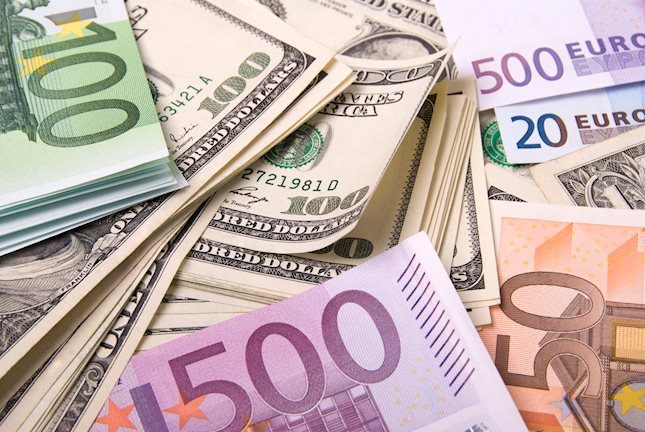- US Dollar retreats as United States election uncertainty offsets upbeat service sector data.
- ISM Services PMI surges, signalling accelerating growth in the sector despite ongoing political concerns.
- Trump's election odds affect US Dollar amid expectations of inflationary policies.
The US Dollar Index (DXY), which measures the value of the USD against a basket of six currencies, retreats as uncertainty surrounding the upcoming US presidential election dampens gains from upbeat service sector data. Despite a surge in the ISM Services PMI indicating robust growth, concerns over the election outcome weigh on the Dollar's strength.
The US Dollar Index has recently declined due to increased probability of Kamala Harris winning the US presidential election and a disappointing October Nonfarm Payrolls (NFP) report released last week. The weak job growth data, despite rising wage inflation, has raised expectations of a less hawkish Federal Reserve (Fed) stance. In the meantime, markets are pricing in a 25-basis-point rate (bps) cut by the Fed this week, which could further weaken the US Dollar.
Daily digest market movers: US Dollar down as US presidential election commences
- US Dollar faces selling pressure as attention shifts toward the US presidential election.
- ISM Services PMI for October exceeded expectations, indicating accelerating growth in the US service sector.
- The ISM Services PMI rose to 56 from 54.9 in September. This reading came in above the market expectation of 53.8.
- Prices Paid Index, a gauge of inflation, eased slightly, while the Employment Index improved.
- Concerns over political uncertainty rose among businesses, as per the ISM survey.
- Markets anticipate a 25 bps rate cut from the Fed next week and another in December.
- Investors speculate that a Trump victory could support the US Dollar due to his inflationary policies.
- There are no Fed speakers this week due to the media blackout ahead of the November 6-7 FOMC meeting.
DXY technical outlook: Bearish momentum grows, support at 103.50
The DXY index is consolidating, possibly indicating a retest of the 200-day SMA support at 103.50. The Relative Strength Index (RSI) is sloping downwards, escaping overbought territory. The Moving Average Convergence Divergence (MACD) is indicating lower green bars, further hinting at a potential retracement.
Key support levels to watch are 103.30 and 103.00, while resistance levels are found at 104.00, 104.50 and 105.00.
Fed FAQs
Monetary policy in the US is shaped by the Federal Reserve (Fed). The Fed has two mandates: to achieve price stability and foster full employment. Its primary tool to achieve these goals is by adjusting interest rates. When prices are rising too quickly and inflation is above the Fed’s 2% target, it raises interest rates, increasing borrowing costs throughout the economy. This results in a stronger US Dollar (USD) as it makes the US a more attractive place for international investors to park their money. When inflation falls below 2% or the Unemployment Rate is too high, the Fed may lower interest rates to encourage borrowing, which weighs on the Greenback.
The Federal Reserve (Fed) holds eight policy meetings a year, where the Federal Open Market Committee (FOMC) assesses economic conditions and makes monetary policy decisions. The FOMC is attended by twelve Fed officials – the seven members of the Board of Governors, the president of the Federal Reserve Bank of New York, and four of the remaining eleven regional Reserve Bank presidents, who serve one-year terms on a rotating basis.
In extreme situations, the Federal Reserve may resort to a policy named Quantitative Easing (QE). QE is the process by which the Fed substantially increases the flow of credit in a stuck financial system. It is a non-standard policy measure used during crises or when inflation is extremely low. It was the Fed’s weapon of choice during the Great Financial Crisis in 2008. It involves the Fed printing more Dollars and using them to buy high grade bonds from financial institutions. QE usually weakens the US Dollar.
Quantitative tightening (QT) is the reverse process of QE, whereby the Federal Reserve stops buying bonds from financial institutions and does not reinvest the principal from the bonds it holds maturing, to purchase new bonds. It is usually positive for the value of the US Dollar.
Information on these pages contains forward-looking statements that involve risks and uncertainties. Markets and instruments profiled on this page are for informational purposes only and should not in any way come across as a recommendation to buy or sell in these assets. You should do your own thorough research before making any investment decisions. FXStreet does not in any way guarantee that this information is free from mistakes, errors, or material misstatements. It also does not guarantee that this information is of a timely nature. Investing in Open Markets involves a great deal of risk, including the loss of all or a portion of your investment, as well as emotional distress. All risks, losses and costs associated with investing, including total loss of principal, are your responsibility. The views and opinions expressed in this article are those of the authors and do not necessarily reflect the official policy or position of FXStreet nor its advertisers. The author will not be held responsible for information that is found at the end of links posted on this page.
If not otherwise explicitly mentioned in the body of the article, at the time of writing, the author has no position in any stock mentioned in this article and no business relationship with any company mentioned. The author has not received compensation for writing this article, other than from FXStreet.
FXStreet and the author do not provide personalized recommendations. The author makes no representations as to the accuracy, completeness, or suitability of this information. FXStreet and the author will not be liable for any errors, omissions or any losses, injuries or damages arising from this information and its display or use. Errors and omissions excepted.
The author and FXStreet are not registered investment advisors and nothing in this article is intended to be investment advice.
Recommended content
Editors’ Picks

EUR/USD clings to daily gains near 1.0300 after US PMI data
EUR/USD trades in positive territory at around 1.0300 on Friday. The pair breathes a sigh of relief as the US Dollar rally stalls, even as markets stay cautious amid geopolitical risks and Trump's tariff plans. US ISM PMI improved to 49.3 in December, beating expectations.

GBP/USD holds around 1.2400 as the mood improves
GBP/USD preserves its recovery momentum and trades around 1.2400 in the American session on Friday. A broad pullback in the US Dollar allows the pair to find some respite after losing over 1% on Thursday. A better mood limits US Dollar gains.

Gold retreats below $2,650 in quiet end to the week
Gold shed some ground on Friday after rising more than 1% on Thursday. The benchmark 10-year US Treasury bond yield trimmed pre-opening losses and stands at around 4.57%, undermining demand for the bright metal. Market players await next week's first-tier data.

Stellar bulls aim for double-digit rally ahead
Stellar extends its gains, trading above $0.45 on Friday after rallying more than 32% this week. On-chain data indicates further rally as XLM’s Open Interest and Total Value Locked rise. Additionally, the technical outlook suggests a rally continuation projection of further 40% gains.

Week ahead – US NFP to test the markets, Eurozone CPI data also in focus
King Dollar flexes its muscles ahead of Friday’s NFP. Eurozone flash CPI numbers awaited as euro bleeds. Canada’s jobs data to impact bets of a January BoC cut. Australia’s CPI and Japan’s wages also on tap.

Best Forex Brokers with Low Spreads
VERIFIED Low spreads are crucial for reducing trading costs. Explore top Forex brokers offering competitive spreads and high leverage. Compare options for EUR/USD, GBP/USD, USD/JPY, and Gold.